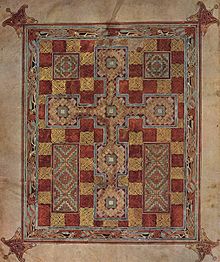
A carpet page is a full page in an illuminated manuscript containing intricate, non-figurative, patterned designs.[1] They are a characteristic feature of Insular manuscripts, and typically placed at the beginning of a Gospel Book. Carpet pages are characterised by mainly geometrical ornamentation which may include repeated animal forms. They are distinct from pages devoted to highly decorated historiated initials, though the style of decoration may be very similar.[2]
Carpet pages are characterised by ornamentation with brilliant colors, active lines and complex patterns of interlace. They are normally symmetrical, or very nearly so, about both a horizontal and vertical axis, though for example the pictured page from the Lindisfarne Gospels is only symmetrical about a vertical axis. Some art historians find their origin in similar Coptic decorative book pages,[3] and they also clearly borrow from contemporary metalwork decoration. Oriental carpets, or other textiles, may themselves have been influences. The tooled leather book binding of the St Cuthbert Gospel represents a simple carpet page in another medium,[4] and the few surviving treasure bindings – metalwork book covers or book shrines – from the same period, such as that on the Lindau Gospels, are also close parallels.[5] Roman floor mosaics seen in post-Roman Britain, are also cited as a possible source.[6] The Hebrew Codex Cairensis, from 9th century Galilee, also contains a similar type of page, but stylistically very different.